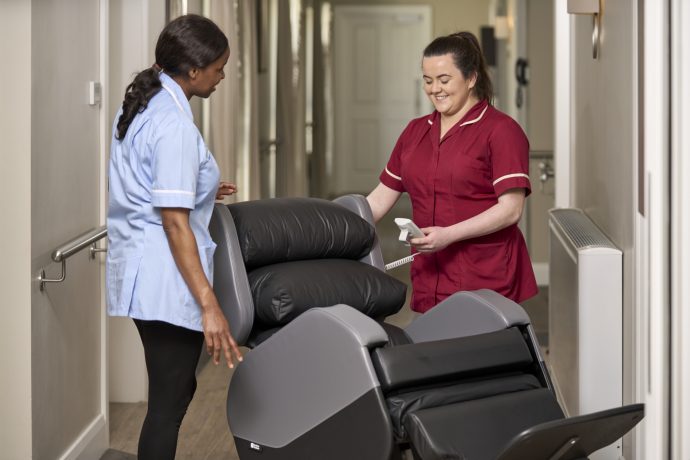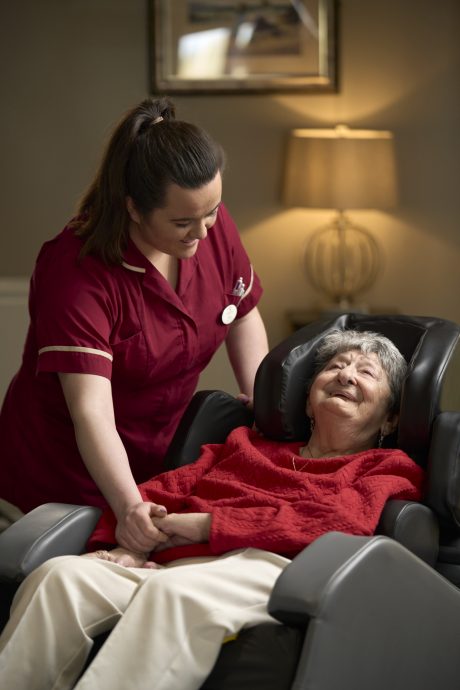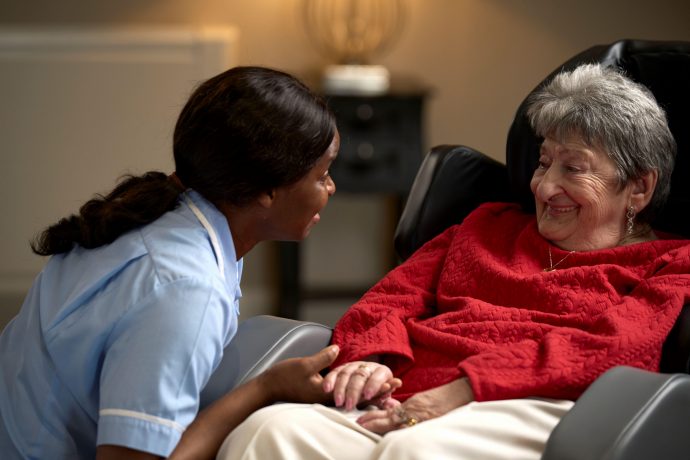
2nd September 2025


Let our online product finder guide you through our simple steps to choose the chairs that best meet your patient’s needs.
Seating Solution FinderThe Envelo cushion provides excellent pressure redistribution and comes as standard on all Seating Matters chairs, meeting the clinical needs of most clients.
Explore Envelo RangeSeating Matters specialises in clinical, therapeutic seating solutions designed to improve patient care and safety, offering products for pressure injury prevention, postural support, and mobility assistance in healthcare settings.
Learn MoreDiscover how Seating Matters has transformed lives with our innovative seating solutions - read our inspiring customer success stories now!
Customer StoriesUsed in academia, in clinical practice and with caregivers around the world to guide their practices around specialist seating.
Download Free HandbookPosture Can Kill! It sounds extreme but it’s true.
We’re going to look at how a bad posture can ultimately result in fatality if it is not corrected over a long period of time. In the days and weeks leading up to a person’s death, especially in elderly patients, often a consistently poor sitting posture has contributed (in some way) to their death.

By definition, it is the position of the body with respect to the surrounding space. Posture is achieved by coordination of various muscles that move the limbs, it requires constant muscular effort.
Posture is regulated by complex systems:
Good or correct posture in seating is described as a seated position where:
This is considered good posture as it takes the least amount of effort to maintain, the body weight is balanced throughout the body, and the person is steady with a stable centre of gravity helping them to stay safe and secure in their chair.
When conducting a seating assessment there might be a large number of goals to be achieved by one seating solution. Each person involved with the seating assessment may be interested in specific goals i.e. the patient wants to be comfortable, the therapists are normally interested in promoting function and activity within the chair whilst the nurses might be primarily focused on maintaining skin integrity/preventing skin breakdown or pressure ulcers. It is very important to understand the link between seating and pressure ulcer development, as pressure ulcers can eventually lead to death.
The goals of seating can be divided into three categories:


We often see deviated postures and it’s important that we can correctly identify the type of posture our clients are sitting in, and consider the causes and effects of this posture, so we are aware of how we can correct/improve upon their position within the chair, thus improving overall well being.
Firstly let’s look at the pelvis.
In a seating assessment, you must begin by locating and assessing the position of the pelvis. There are four common pelvic presentations which contribute to a deviated posture. If the pelvis is tilted or deviated in any way due to a deformity or lack of support, the muscles in the hips, trunk and neck must work harder to keep the person from falling over and to maintain a midline position.
A posterior pelvic tilt is identified by the PSIS becoming lower than the ASIS with the pelvis tilted backwards. It is commonly known as ‘sacral’ sitting as the position of the pelvis leads to the person putting weight on the sacrum.
Some of the clinical causes of posterior pelvic tilt include sliding forward in the seat, tight hamstrings, limited hip flexion, or an increase in muscle tone. Some of the technical causes of a posterior pelvic tilt can be that the seat depth is too long, or the footplates are too low.
A posterior pelvic tilt can cause many difficulties physically and physiologically, such as difficulty swallowing, communicating and breathing. A person sitting in a posterior pelvic tilt is at high risk of pressure ulcers especially on the sacral region, but also on the heels/feet, as the person uses their feet to anchor themselves from sliding.
A less common pelvic position than the previous, this is identified when PSIS is higher than the ASIS, tilted forward.
An anterior pelvic tilt can be caused by a range of clinical and technical factors such as weakened abdominal muscles, obesity, lordosis of the spine or the back of their chair being too vertical or the seat being too sloped. Anterior pelvic tilt is commonly associated with people sitting for long periods of time at a desk, or in people with obesity who have increased mass at the front of the body which pulls the pelvis forward, putting weight on the pubic region.
As the ITs push backwards the weight of the person is put through the pubic region creating a high pressure risk. An anterior pelvic tilt can cause bladder issues, digestion issues, as well as spinal and back pain.
A pelvic obliquity is caused by one side of the pelvis being higher than the other, tilted to one side, causing uneven weight distribution through the ITs.
It can be caused by instability of the person, or instability of the chair. If a person is constantly leaning to one side because their body is not supported in their chair, e.g. the chair is too wide is can cause a pelvic obliquity, or if someone has a weakness on one side, e.g. a hemiplegia, this can also cause a pelvic obliquity. It is usually common with scoliosis, or hip dislocation or subluxation.
Pressure injuries can occur on the lower IT which is taking extra weight. Scoliosis can be both a cause and effect of pelvic obliquity and thus has can have associated issues with internal organs on the affected side and possibly affects the ribcage. Another effect can be an increased level of muscle tone from ‘fixing’ themselves in the chair if it is not proportionate to their needs.
A pelvic rotation is characterised by one ASIS being in front of the other, and a pelvic rotation is named according to the direction of the rotation.
A pelvic rotation can be caused by a leg length discrepancy, hip dislocation, subluxation or asymmetrical hip flexion or adduction. Some technical causes include a seat that is too wide, or a chair which does not provide adequate trunk support.
It is also common in those with a pelvic obliquity, and can lead to a windswept deformity.
When carrying out a seating assessment, as well as determining the pelvic presentation we need to consider the spinal presentation of the client. There are three main spinal presentations to be aware of:
Lordosis of the spine is identified by an increased lumbar curve and is associated with anterior pelvic tilt. It can be caused by weakened abdominal muscles relative to the extensor muscles, or tight hip flexors and can cause a lot of back pain.
A scoliosis can be "C" shaped or "S" shaped and is usually associated with a pelvic obliquity. In assessing a patient with scoliosis we need to establish if the posture is fixed, partially fixed or correctable. Scoliosis can have serious health complications depending on the severity of the posture and can impact on internal organs and cause issues with the patient’s ribcage.
A kyphotic spine is characterised by a ‘hump’ back in the upper thoracic region and is usually associated with posterior pelvic tilt. It can greatly reduce physiological function and needs to be accommodated in seating. Again, we need to establish if the posture is fixed, partially fixed or correctable.
The hamstring pulls over two joints, the knee and the hip. If hamstrings are tight or contracted, this can have a profound negative impact on sitting posture. Hamstrings need to be measured correctly and accommodated in seating. Many clinicians don’t know the importance of this or are unsure of how to measure hamstrings properly.
In considering all of these pelvic and spinal presentations, we need to establish whether the positions are fixed, partially fixed or correctable, so that we can tailor a seating solution to suit the patients needs.
If the posture is fixed we need to know how to accommodate this posture using the functions within the chair, helping to slow down deterioration of the abnormal posture. If the posture is flexible or partially fixed you can slowly attempt to correct this by using the correct seating and accessories.
Our range of seating has various accessories and functionality to support each of these positions, from added lateral supports to encourage mid line position, to the ergonomic head and shoulder supports of the Phoenix chair, which can ‘hug’ a kyphotic spinal position and provide un-paralled support. Adjustable ‘wings’ on both sides of the Phoenix can support complex spinal presentations enabling adjustable support along one side i.e. the affected side resulting from a hemiplegia or a scoliosis, to slowly bring the posture back to a midline postion, if the posture is partially fixed or correctable.
The importance of a seating consultation should never be underestimated. The seating consultation should identify the key goals to be achieved to improve the persons function, psychological and physical quality of life. We have Seating Specialists across the world who have been clinically trained who can visit your facility to carry out a FREE, no obligation seating consultation.
From there we can arrange a trial in the recommended chair so the patient can see for themselves how it works for you.
Sign up to our mailing list to get practical tips and latest research delivered to your inbox!
Take the next step to achieve clinical excellence and a 24 hour package of care for patients.

Arrange a free, no obligation seating consultation with your local Seating Specialist.

Schedule a call at a time that suits you to speak with our experts.

Arrange a free, no obligation trial of clinical, therapeutic seating

2nd September 2025

15th August 2025

15th August 2025